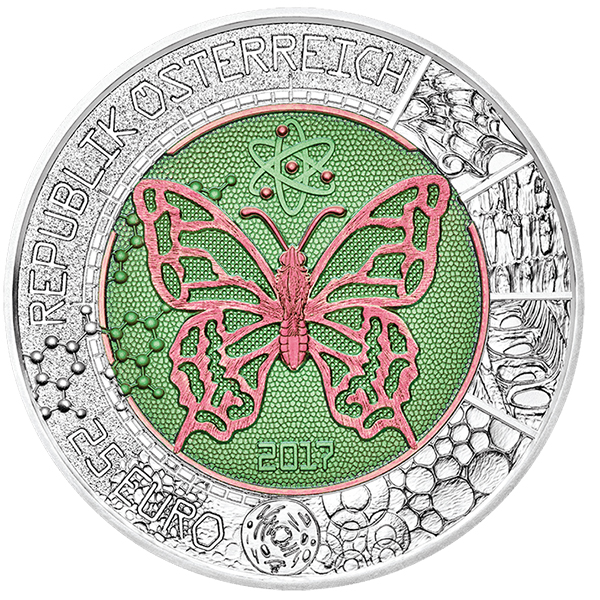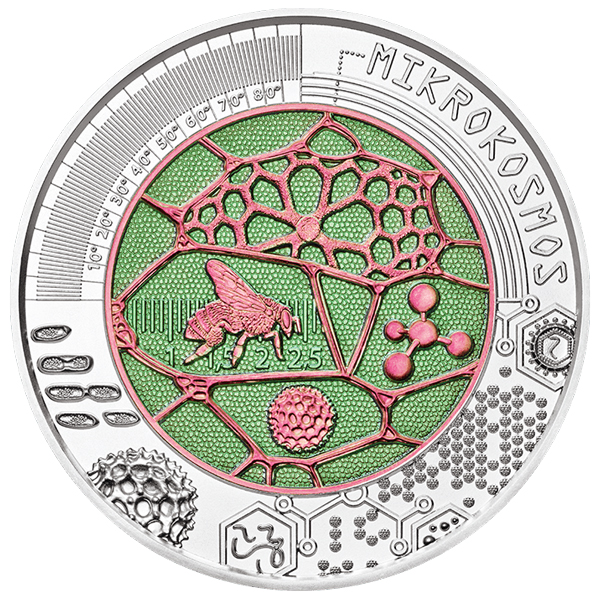
Description:
“Microcosm“, the 2017 entry in the popular Austrian Mint 25 euro silver-niobium bimetallic coin program honoring science and technological innovation, is the 15th issue in the series. A quick glance at the muted colors on the niobium center of Microcosm reveals how far the Austrians have developed not only the series but the technical expertise required to produce such varieties of tone in the niobium alloy.
After exploring the vistas of space (Cosmology, 2015) and time (Time, 2016), the Mint has focused on the inner space of the microscopic. To do so, designers Helmut Andexlinger and Herbert Wähner have chosen to portray a butterfly and its wings at different levels of magnification – all the way down to individual cells undergoing mitosis (cell division).
Legal Tender in Austria, the 2017 Microcosm Silver-Niobium 25 Euro Coin measures 34.00 mm in diameter and weighs 16.50 grams in total. The outer ring consists of 90% pure silver while the center disc is composed of primarily niobium, a soft, ductile metal when pure that is hardened by impurities.
The coin was carefully struck and handled in the Austrian Mint’s Special Uncirculated finish. A total of 65,000 pieces were struck. In its original packaging, each coin comes in a plastic coin capsule, which fits snugly inside of a burgundy box. A serially numbered certificate of authenticity was also included.
Obverse:
The predominant feature on the obverse is the “raspberry-red” butterfly set against a “grass green” field (Mint’s descriptions) on the niobium inner disc. The colors are produced via a special oxidation process, which, as mentioned above, the Austrian Mint has refined over the years in order to produce subtle shading.
The green field behind the butterfly is actually patterned much like the scales of a butterfly’s wing when viewed close-up. The butterfly’s head, thorax and abdomen are rendered naturalistically, but the wings are designed in a manner similar to stained glass, with heavy internal borders delineating translucent sections. The pattern within the butterfly’s wings differs from that of the “field” in that the wing pattern is made of a multitude of compact spherical shapes.
Sadly, CoinWeek is not able to identify the genus and species of butterfly portrayed.
Also on the inner disc, above and between the butterfly’s antennae, is a depiction of an atomic model as conceived by Danish physicist Niels Bohr. The nucleus and three revolving electrons are colored the same red as the butterfly, while the orbits are a lighter green than the field. A molecular model crosses over from the left of the outer ring and is partially hidden by the butterfly’s left wing. The year 2017 is inscribed beneath the butterfly in a font resembling one that may be used on an older computer terminal.
A red ring surrounds the inner niobium disc, except where the tips of the butterfly’s wings interrupt it.
The outer ring, made of .900 fine silver, is divided into a number of uneven sectors and contains a larger variety of designs and textures. Starting on the left, the inscription REPUBLIK ÖSTERREICH (“Republic of Austria”) occupies and extends past the top left quadrant. A fibrous-looking texture is found behind it, while a ring of small rectangular blocks – a few shaded in – encircles about half of the inner portion. This ring appears to be some kind of measuring implement.
On the other side of the previously mentioned molecular model (located right below the “R” in REPUBLIK) is the denomination 25 EURO. The numerals “25” are located on top of the same fibrous background as REPUBLIK ÖSTERREICH, but the word “Euro” appears to float above another section of the outer ring where individual cells are visible.
Returning to the top of the coin, immediately after the word “Österreich” is an image of a butterfly’s wing. Proceeding clockwise from this image moves the viewer’s eye through sections that represent progressively higher magnifications of the same object until finally, at the bottom of the obverse, we see individual cells. The biological machinery of an animal cell is portrayed on the outer silver ring beneath the date 2017.

Reverse:
A wealth of detail is also present on the reverse. The central disc shows a close-up of the surface of pollen. Within one of the cells is a realistic portrayal of a bee, its physiognomy accurate enough to confirm that it is a female. To the right of the bee is a 3D model of a chemical compound that resembles that of methane (CH4). Below the bee is a pollen grain.
Like the obverse, the green field on the niobium disc features a scale-like pattern, which on the reverse may be based on either the bee or the butterfly. Behind the bee, however, are what look like the marks on a ruler, with numbers ranging from “1” to “2.5” (in some countries, a comma is used instead of a decimal point). The red ring that surrounds the inner disc and divides it from the outer ring is here unbroken.
Unlike the obverse, the outer ring is somewhat “cleaner”, having less background detail and more “negative space”.
Beginning in the upper left quadrant yet again and looking clockwise, the viewer first sees a length of some form of measuring tool, perhaps a protractor since the units are marked off in degrees (by tens, from 10 to 80). To the left of the “protractor” is the inscription MIKROKOSMOS, surrounded by various solid and dotted lines.
Beneath the inscription MIKROKOSMOS is a partial hexagon with what appears to be a rhinovirus, or cold virus, inside. A number of small shapes that may be pollen or viruses are massed together in the lower right of the reverse alongside various chemical, viral and bacterial shapes. To the left of these shapes is a larger pollen particle, and above it is a four-stage depiction of the division of a cell into two daughter cells.
Edge:
The edge of the 2017 Microcosm 25 euro silver-niobium coin is smooth.
Designer(s): Austrian Mint designer Helmut Andexlinger is one of the world’s leading coin designers. He has created a number of prize-winning coin designs (View Designer’s Profile). Herbert Wähner is a designer and engraver at the Austrian Mint. Both men studied at the Fachschule für Metalldesign in Steyr, Austria.
Coin Specifications:
| Country: | Austria |
| Year Of Issue: | 2017 |
| Denomination: | 25 Euro |
| Mint Mark: | |
| Mintage: | 65,000 |
| Alloy: | Niobium center, .900 Silver outer ring |
| Weight: | 16.50 grams |
| Diameter: | 34.00 mm |
| Edge: | Smooth |
| OBV Designer | Helmut Andexlinger | Herbert Wähner |
| REV Designer | Helmut Andexlinger | Herbert Wähner |
| Quality: | Special Uncirculated |




